Empire / Regency (approx. 1795-1820)
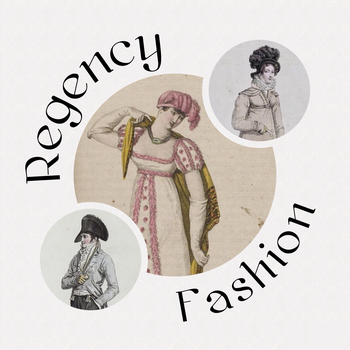
The high-waisted style of Jane Austen heroines, Bridgerton debutantes and famous historical figures like Empress Josephine Bonaparte is as present in popular culture as in a museum.
There is a variety of terms applied to this dress style.
The "Empire" waistline (stress French: „om-peer“) received its name from the first French Empire under Napoleon I. The
"Regency" era in the United Kingdom encompasses the period of time when George IV ruled from 1811 to 1820 as Prince Regent for his incapacitated father George III, thus marking the latter
part of the time referred to as Georgian era. In the German-speaking lands, the late Regency overlaps with the Biedermeier style period. Empire and Regency style is also referred to as
Neoclassicism when referencing Ancient Rome and Greece. Overall, this dress style follows on from the extravagant 18th century styles with wide skirts and powdered wigs and remained until the
Victorian era saw the rise of corsets and the cage crinoline hoop-skirt.

The French Revolution took place from 1789 until 1799 and had great influence on the fashion of that time. The people of France,
chiefly Paris, fought against absolutism and the arbitrary domination of the kings of the „Ancien régime“, as well as against the extravagances of the nobles while many working-class
people famished during bad harvests. Nonetheless, the subtle social and artistic shifts that brought on the new dress style without paniers, wigs and stays had already begun many years
prior.
Flowing white robes had already emerged before the Revolution in the form of the Chemise dresses. The increased study of antique works of art, together with the intellectual trend of the Enlightenment and its return to nature and simplicity, brought the flowy gowns into the forefront of fashion in the second half of the 1700s. The famous artist Elisabeth Vigee-Lebrun, for example, held a much remarked-on dinner where everybody was clothed by her in the manner of antique sculptures and all wore flower or laurel wreaths on their heads. Fashion thus began gradually to follow classical ideals, inspired by the ancient Greek and Roman styles with their draped and gathered dresses.
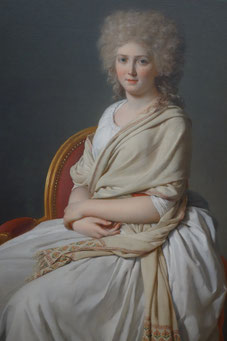
Those Chitons and Peplos, together with the Roman tunics, formed the point of inspiration. The Empire silhouette thus defines a dress with a high waist and a long and loosely falling skirt. This portrait of Anne-Marie-Louise Thélusson, Comptesse de Sorcy, was painted in 1790 by Jacques-Louis David. The late Rococo hairstyle with powdered hair, pale skin and rouged cheeks is paired with the simple dress and shawl of the Empire style. This demonstrates the complex and gradual transition between Rococo and Empire styles, rather than being sharply divided into before and after by the French Revolution, as sometimes takes place in pop culture and historical media. Besides, at the English court, Empire-waisted dresses were worn over Rococo sized hoops for many years into the 1800s, creating a rather odd look.
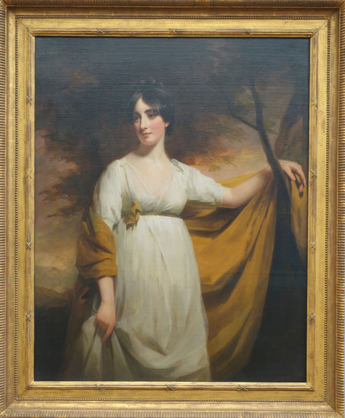
The dresses were gathered under the bust to give them shape. The favoured white Muslin was first imported from Europe's overseas colonies like India and then also produced locally. White was a favoured colour as it was the colour of ancient marble statues (although most ancient Greek and Roman statues were vividly painted in their day). White, being easy to wash and bleach, was worn both for special occasions like evening assemblies and balls, and at home. It also demonstrated a certain social standing and most members of the landed gentry forbade their female servants from wearing white gowns over fears it would make them think beyond their station in life. Increasing wealth among the middle class, together with sinking costs of cloth and clothing due to industrial manufacturing, led to ladies changing their clothes a number of times throughout the day. There were different types of clothing for different activities and the fashion magazines of the day, such as Costume Parisien or Ackermann‘s Repository of Arts, published the latest styles for each type regularly:
-
the Home Costume, the Morning, the Walking and the Promenade Dress (informal
"Undress")
-
the Afternoon, Dinner and Opera Dress (called "Half Dress", semi-formal)
-
the Evening, Ball and Court Gowns ("Full Dress", usually had trains (pinned up for dancing))
- the Riding Habit (women's clothes for horseback riding, normally very long to cover the legs when sitting on horseback))
-
the Carriage Dress
- mourning attire
-
and the seaside bathing dresses
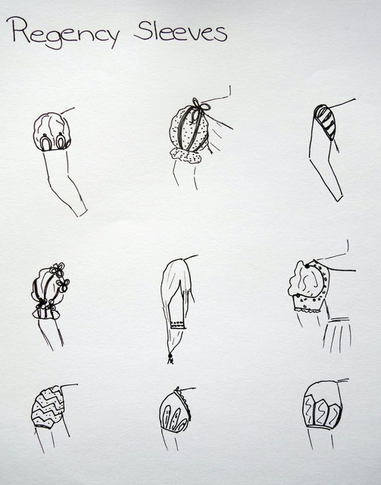
Making a dress by hand was a great deal of work and surviving garments show different kinds of
stitches in different parts of the garments.
Needlework was part of women's education of most ranks. Nearly every young lady learned basic
sewing and embroidery techniques at home. Needlework was the most popular pastime. Although linen items were made at home, and dresses were often embroidered and bonnets trimmed by the wearers,
most items in a person's possession would have been made by specialists with tailoring experience. Most country towns had dressmaking shops, haberdashers and milliners, and whenever a relative
travelled to London, they were charged with bringing back reports of new styles as well as new articles of clothing.
A woman's dress required several metres / yards of fabric. There was a very active trade in
second-hand clothing and they were handed down the social order. Ladies of wealth would hand dresses to their maidservants, these would sell them on when worn out, and finally the clothes would
be collected to be boiled to pulp to make paper.
For a vast variety of different dresses and styles take a look at fashion copperplate prints (e.g. "Costume Parisien", "Ackermann's Repository" or "La Belle
Assemblée") - here you can find a few examples out of my own collection:
UNDRESS * RIDING HABIT * CARRIAGE DRESS
HALF DRESS * FULL DRESS
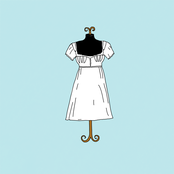
Under the visible dress, several undergarments had their place:
First of all, the chemise (also called shift), a thin, low-cut and short-sleeved underdress made of cotton in soft colours, that should protect the upper layers from e. g. body odour; a shift was also worn to bed).
Over this shift go the stays which shape and push up the bust. These are either around the length of a modern
sports bra - then called short stays - or reach down to the hip bones - then called long stays. These are not to tight-lace the wearer, as is sometimes made much of in period dramas. Indeed in
Empire line dresses, tight-lacing would be of no use as the waist is hidden under the skirt anyway. The stays are, like a bra, a shaping garment. The Regency's idealised bust was separated over
the sternum and cupped, pushed upwards (one might say like peaches on a plate...) to match the low necklines of evening dresses.
The stays are followed by the petticoat (not the typical 1950s
garment but a sleeveless dress or cut as a long tube skirt starting under the bust held by long shoulder straps). The
less expensive and easier to bleach material of the petticoat still covers the legs and ankles even if muddy roads force the wearer to lift the outer skirt. But beware to show yourself like this
in the elegant house of "a single man in possession of a good fortune" or be prepared to hear his his sisters spiteful remarks about your hem being "six inches deep in mud" (see Pride and
Prejudice).
The bustle pad, a small padded half-moon-shaped pillow the size of a fist, was worn underneath the outer dress. Usually it
was attached inside a dress under the bust line or attached to the stays. Its function was to assist the fall of the skirt by holding out the gathering at the back to preclude the skirt from
caving in into the small of the back.
Over the petticoat the gown is worn. Long-sleeved and high cut for daytime wear or glamorous, low cut and with short puffed sleeves
for a ball - gowns came in an infinite variety and were, due to the bespoke nature of dressmaking in this era just before industrial clothes production, highly personalised. Gowns were made from
linen, cotton, silk, wool, or fibre blends. The rise of printing brought many fashion magazines into circulation and fuelled the speed of changing styles. To be always in the first style of
fashion was a pastime limited to the upper-classes of independent wealth. Most people bought very few new articles of dress in a year and rather had garments re-tailored to match new cuts or
changed decorative trim themselves to go with the times.
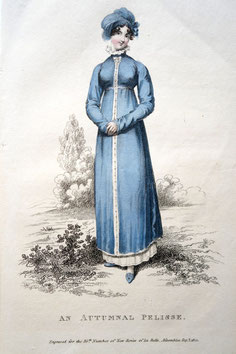
A pelisse was a long coat with likewise long sleeves. Pelisses were high-waisted and usually made of fine fabrics. They could be
plain or adorned with trimming, fine buttons, braid and embroidery. The colours for autumn could be darker and bolder than those for spring and summer, when light shades were more appropriate. In
the same way, fabrics for summer and winter differed.
For a lesser degree of protection from the elements, a Spencer could be just the thing. This short (ending just under the bust) and
fitted jacked, was essentially a Pelisse without the skirt.
The name Spencer goes back to Lord Spencer who is said to have singed the tails of his coat at the fireplace and then cut them off, creating a short jacket.
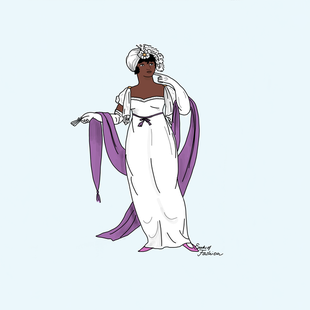
For protection from the cold and draughtiness of the houses and to spice the (white) dresses up, colourful shawls and wraps were worn. The word „shawl“ has its origin in the Persian language and originally described a woollen garment for men. Adapted by central Europe, these wraps soon gained fashionable importance in the cultural centres like London and Paris. They were imported from India and later also manufactured in Europe, where the Scottish city Paisley became known for them and lent its name to the distinctive drop-shaped pattern. Napoleon's wife, Empress Josephine, famously owned hundreds of shawls.
Long overcoats, cloaks, capes and mantelets made of wool, merino and velvet and trimmed with fur were much in demand, too. One of
those garments was the Redingote, a top coat quite alike to a dress but in closed in the front (often buttoned) and made of hardwearing and somewhat water-repellant cloth, was useful for
journeys on horseback and being out in poor weather. The Redingote had originally been an item of men's clothing and the name is derived from "riding coat." In some cases the protecting was
supported by being made of several layers and/or shoulder capes to prevent getting wet through. The skirt was cut overlong to cover the wearer's feet when up on horseback in side saddle or
perched in the box seat of an open carriage.
During the winter months, women resorted more protecting cloth like fine wool, linen and heavier velvets and tried to keep warm with flannel petticoats or more undergarments. Despite this, falling ill from too light clothing was a talked-about threat to women. Most illnesses like consumption (tuberculosis), and other bacterial and viral infections, were contracted in unhygienic conditions like in packed ballrooms and through uncleaned or poorly washed drinking glasses circulating around the assembly. Tuberculosis was, however, also called “muslin disease” and its discussion had moralising undertones about the dangers of fashion to the minds of young ladies. The upcoming Romanticism with all its poetry about unrequited affection and the melancholic Gothic, made the ailing and frail look of the consumptive a (questionable) fashion among a section of the population. In Sense and Sensibility by Jane Austen, Elinor Dashwood says to her romantically-inclined sister Marianne on the subject of their friend Colonel Brandon wearing flannel waistcoats: "Had he been only in a violent fever, you would not have despised him half so much. Confess, Marianne, is not there something interesting to you in the flushed cheek, the hollow eye, and the quick pulse of a fever?"
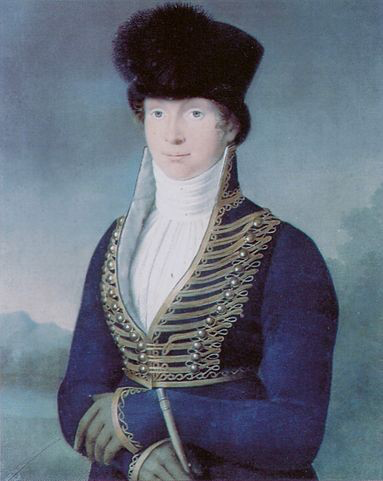
Influenced by male dress, a military-inspired style was adopted into outerwear, such as spencers and pelisses. This is an old phenomenon, already riding habits of the 1600s and 1700s deploy male-connotated pattern cuts and decorations. The (higher ranked) members of the army in their glamourous uniforms with decoration were considered to be extremely fashionable, and a well-to-do officer to be a good match for a daughter. The military was highly present in early 19th century society in Europe, glorified and feared. The Hussars were considered particularly dashing in their uniforms.
The Queen of Prussia, Luise, wore a matching ensemble of hat, Spencer and dress in the style of men's uniforms when visiting a regiment given to her by her husband, the King.
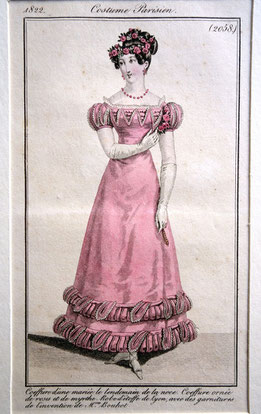
Wedding gowns were not
necessarily white. Red, yellow, blue, pink and light green, even brown, were worn. Less prosperous women wore their best dress, wealthy ones had their attire made or bought exclusively for the
wedding, consulting the latest fashions in London and Paris and spending great amounts of time on choosing the perfect lace veil, the most luxurious fabrics and the place of every embroidery. Not
only the particular dress for the ceremony was bought but the whole wardrobe was brushed up, worn-out things were replaced or mended, new linen, dresses and accessories bought. This was
considered part of the dowry.
Another way to embellish the garments was using lace, among which Brussels lace was the most fashionable. Brussels lace is a bobbin lace, first entirely made by hand, later with machines to meet demand. That lace is braided with threat wound on wooden, bone or even ivory bobbins and the already woven lace is held with pins on a (straw-filled) pillow. The complexity of this time-consuming working process is gigantic and thus the cost of the lace very high. It could hence only be purchased by the wealthy.
Usually, flowers were worn as a floral crown or worked in the hairstyle for festive wear, styling the wearer as an antique goddess of plenty or personification of spring. This print here, though actually from 1822, shows (as is stated in French underneath) 'the hairstyle of a bride the day after her wedding. The hair is adorned with roses and mytle, the robe of fabric from Lyon with decoration invented by Madame Bouhot'.
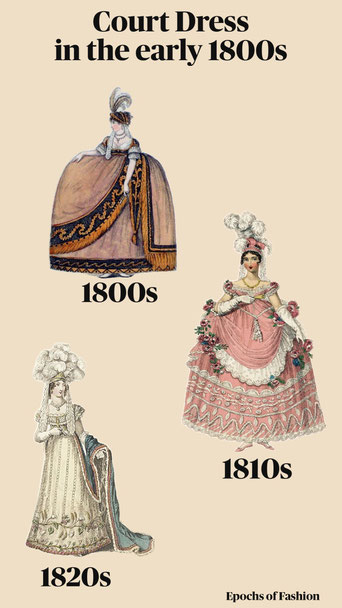
The Court Dress:
Court Dress for a long time still contained hoop skirts like in the later 1700s. Queen Charlotte was adamant to keep them while she reigned.
The hoops were dropped after her. Court dress then had narrow Empire skirts, following the latest fashion but also remaining distinct in its splendour and use of the highest materials. A long train was a firm part of court dress and this gave rise to a petition in 1834:
THE UNGRACIOUS PETITION. -Our attention has been called to a Petition of a most extraordinary nature, which has recently been presented to the QUEEN, and to which her Majesty has been pleased
to reply in a manner which we think will prevent the ladies of the Court of Great Britain from again addressing her Majesty in such ungraceful terms. The Petition we allude to, was the same, or
similar, to that which was sent to her Majesty last year, and we should have thought that the marked expression of the Queen's displeasure upon that occasion would have prevented a repetition of
the offence.
As it is, to say the least of the matter, the Ladies of England have given existence to a document which will be an everlasting record of their parsimony, and indifference to the interests
and well being of the community. They have found the cost of Court-dresses to be so very great, that they implore her Majesty to allow them to discontinue trains!
They plead, that at the Court of France such appendages are disused, and humbly beseech her Majesty to allow them to follow the example of their Parisian contemporaries. The reply of her
Majesty is noble and truly patriotic: that right-royal lady, in the boundless generosity of her own affectionate heart, refuses the extraordinary request, and in plain terms commands the Ladies
of her Court never to appear in her presence upon Court days, unless attired in that style of splendour and elegance which has ever characterized the Court of Great Britain.
Queen ADELAIDE has expressed her desire of enforcing more rigorously than ever, the Court Costume as established by King George the Fourth; exacting that the train should be attached to a
corsage, so as to form a complete dress, and not a separate appendage: alledging the important advantages derived by trade from a continuance of the fashion. Her Majesty here appears in the light
of advocate and enforcer of the claims of the manufacturer, trader, and indeed of the humblest artisan, all of whom would suffer if the use of trains at Court were to be discontinued.
Some ladies, we regret to say, are quite indifferent as to other persons, so that they are enabled to save a few guineas, to spend at card-tables, and in other unworthy pastimes. We have seen
enough of their disloyalty in their use of old dresses: and they would crown all by throwing off their trains!
- World of Fashions and Continental Feuilletons, May 1834
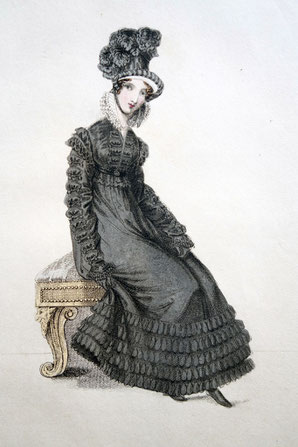
Mourning times had their own etiquette. Before mass production, a wardrobe especially for mourning was beyond most women's means so they could only show their mourning by a
few dark elements in their dress. The mourning colours were black (for the first period) then it kind of faded out during the half-mourning with colours like grey, dark blue, purple and lilac.
The cut allowed only a minimum of visible skin. The dresses were combined with matching pelisses, dark shoes, white or dark gloves, mourning bonnets and caps. If a member of the family or a royal
passed away, a certain period of time had to pass before e.g. a marriage could be celebrated. In Jane Austen's Emma, for example, Miss Fairfax and Frank Churchill are obliged to wait for
the three months of deep mourning to pass after his aunt had died until they can be married.
The mourning periods expected to be observed by female relatives of the deceased were generally longer than those of male relatives. A husband mourning the loss of his wife was by etiquette
only obliged to go into seclusion for a couple of weeks and wear mourning dress or ribbons for about a year. As black was a colour of daily wear for men this was no great rearrangement. In
Persuasion, widower Mr Elliot publicly pays court to his cousin Anne only a few months after having lost his first wife. A widow, however, was not supposed to attend plays or dance or go much
into public in general for a year and a day. She was also not to remarry within that period. Reality in sources from the time period show, though, that people were more flexible than these
'ideal' timelines. People did go into society during mourning and even remarried, whether by inclination or financial necessity, compelled by their individual lived realities.
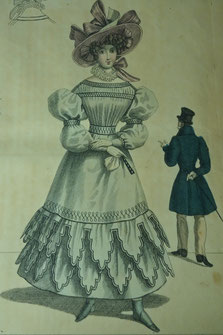
1820s and 30s - the in-between decades between Regency and Victorian:
Towards the end of the Regency/Empire epoch around 1820, the high empire waist began to slip down
about an inch every year.
By the mid- to later twenties, the waistline reached a natural level of the human body again. The Regency's gentler long stays changed into increasingly stiffened corsets, although few women tight-laced to the point of discomfort. The wasp-waist look was chiefly created by a clever use of visuals, where it looks narrower to the eye next to the increasingly full skirts and wide shoulder style with puffed sleeves.
These puffed sleeves gave way to the so called “leg-o-mutton” sleeves where the sleeve is not any
longer constructed as a puffed sleeve with an attached tight sleeve below but as a one-piece mutton-leg shaped sleeve. Those sleeves, most popular in the mid 30s, needed to be supported. They
were shaped by big pads akin to modern water wings around the upper arms, or by under-sleeves with sewn-in boning.
The new fashionable silhouette thus was a broad upper torso and a full skirt which formed the
appearance of an hourglass or rather as two triangles meeting at their tips.
In this time, the Romantic Movement had reached its zenith: The Romantic fiction and historical
novels and plays were loved very much by a great readership. As a consequence, Early Modern dress influences found their way into 19th century fashion, such as ruffs.

Accessories:
Gloves were a vital part of everyday wear, being put on when leaving the house, going to Church and even for social events like dinners and balls. Thus, glove fabrics varied depending on the usage and setting in which the gloves would be worn - from
fur-trimmed leather to fine, embroidered silks.
The handkerchief was a very important accessory, neatly embroidered with
whitework, flower stitchery or a monogram, trimmed with lace and scented with perfume. It could be used for signalizing feelings, intentions or
flirting discreetly. A folding fan, painted with motives, was made of
wood, ivory or mother of pearl with painted paper, fabric or lace or feathers. It was used by both ladies and gentlemen to cool themselves. Although there was a 'fan love language' and some women
used these utensils to communicate flirty messages, it was not an incredibly common, understood and done by everybody kind of practice.
To protect the complexion from too much sun, parasols were a great help and also had a fashion-factor. When Lady Catherine de Burgh arrives at Longbourn she forces Elizabeth to walk with her for which the heroine needs an important accessory: "Elizabeth obeyed, and running into her own room for her parasol, attended her noble guest down stairs" (Pride and Prejudice, Jane Austen).
As the Regency dresses left no room for pockets (pockets would deposit and detract the drape of the fabric) women used to carry around their important things (the essential handkerchief and perhaps powder and smelling salts) in little handbags, called reticules. Those small pouches were gathered with a drawstring and beautifully embroidered, usually with floral motives. The shapes are numerous, everything from spherical over pear-shaped to polygonal – or even looking like a pineapple. The reticules colours were sometimes chosen to match a dress or made of fabric remnants.
Salts or lavender water in pretty vinaigrettes cured fainting
fits or protected from bad smells in the streets. The strong smell of vinegar or scented salts caused a person to breathe in sharply and revive more quickly through better oxygen supply. Lavender
water was applied to ones handkerchief to dispel headaches or fatigue.
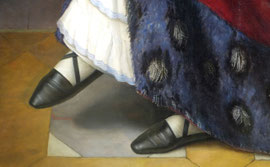
Shoes:
After the brocade, buckle-closed and high-heeled shoes of the Rococo Era a distinctive change happened. In 1800 and after, fashionable shoes were the flat and thin slippers made of
fabric or leather (they looked a bit like ballet shoes or slippers today). They were worn for activities in the house and for dancing (nowhere near dirt, however). Pastel shades or black were
chic and the slippers used to be decorated with fabric rosettes, bows or embroidery. In Jane Austen's Pride and Prejudice, the shoe rosettes for the Netherfield Ball are brought to the
Bennet sisters who can't leave the house because the weather is so bad.
Furthermore, the slippers could be like ballet flats today or have ribbons to be laced cross-wise over the ankle and be tied there (like the shoes of a ballerina). Usually, the slippers were quite pointed.
For bad weather or longer walks, boots or half boots were worn. In Jane Austen's fragment of a novel, "The Watsons," Lord Osbourne talks about women's yellow-and-black boots. In the making process both the left and right shoe was made the same way so that no special shoe for every feet existed.
Beauty:
Freshness and a natural look was the beauty ideal of the Regency/Empire epoch. There is an enduring social tendency to look at make-up as artifice and fakery, and this was already the case in the early 1800s.
Luise of Mecklenburg-Strelitz, Queen consort of Prussia from 1797 to 1810, said that if she wanted to tease her husband, she threatened to put make-up on which he did not like at all.
If people sought products, a ‘no make-up make-up look’ was preferred. Burnt cloves could be used as eyebrow pencils (this works surprisingly well!), and rouge was available too. Although the Regency era no longer employed lead-based 'ceruse', foundation make-up sold by apothecaries and suppliers was often still of questionable ingredients. Magazines from the period often feature advertisements for health and beauty products and many read to modern minds as rather dangerous concoctions.
To get or maintain clear skin, enumerable offerings were made by reputable doctors and by quacks in print magazines.
Tooth hygiene was known to be important to prevent decay and people employed abrasive or bleaching pastes and tooth brushes to keep their mouths clean. Nonetheless, the great popularity of sugary foods of the era together with lacking dental hygiene meant that many people unavoidably suffered from bad teeth.
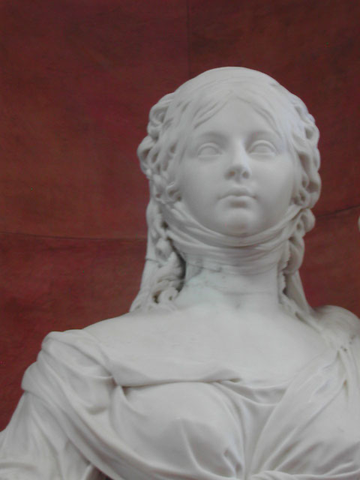
Hair:
Ancient Greek and Roman culture was not only drawn from for inspiration for gowns, but also for hairstyles. The hair was grown out long, if health allowed. It (or helping hair-pieces) was
drawn up to buns or braids, while the hair around the face was worn in fine ringlet curls. Directly after the French Revolution, short hairstyles were en vogue. A whole range of paintings and
portrait miniatures attest to this. The hairstyles had names like 'à la
Titus' (short, curls), 'à la Victime' (cut
short, like the imprisoned during the French Revolution) or 'à la Ninon' (in curls).
About hair decorations Jane Austen wrote to her sister Cassandra from Bath in June, 1799: "Flowers are very much worn, and fruit is still more the thing. Elizabeth has a bunch of strawberries, and I have seen grapes, cherries, plums, and apricots. There are likewise almonds and raisins, French plums, and tamarinds at the grocers', but I have never seen any of them in hats. A plum or greengage would cost three shillings; cherries and grapes about five [...]". Later in June she wrote mockingly: "I cannot decide on the fruit until I hear from you again. – Besides, I cannot help thinking that it is more natural to have flowers grow out of the head than fruit. – What do you think on that subject?"
Leaving the house as woman meant putting on a head covering. Hats and bonnets were made of straw, buckram, and wool and other dress fabrics. Caps were worn at home by married women.
There were countless styles of bonnet and cap shapes and their ever-changing decorations for the
latest seasons. Bonnets were wide-brimmed, tubular and tight-sitting (poke bonnets), high (stovepipe bonnets) or shaped like an ancient Greek or Roman helmet. Popular hat-trimmings were
artificial flowers and fruit, feathers and ribbons. A veil of lace or sheer fabric could be added to the brim of the hat or bonnet to add formality. Decorations were frequently exchanged to keep
up with changing trends. Jane Austen wittily captures this by having Pride and Prejudice‘s Lydia Bennet speaking about trimming a new bonnet afresh to be more to her taste.
Ostrich feathers had been used as hair and hat decorations for centuries, but in the 18th century tall plumes became a dress essential among the fashionable set.
Feathers in headwear stayed through the Revolution and their use continued unabated in the Regency. By the early 1800s, so many ostrich feathers were imported into France, the United Kingdom and
neighbouring nations that ostriches went almost extinct.
By the late Victorian era, whole birds adorned hats and several kinds were almost brought to extinction. In this time, it was especially the colourful birds of the Americas that were most popular and a large volume cross-Atlantic trade brought tens of thousands of birds into the European dress market. In Boston in 1896 a group of boycotters formed around Mrs Harriet Hemenway. Aided by them, the first regulations were brought in by the early 1900s, and through the 1910s and 1920s, birds and plumes went slowly out of fashion.




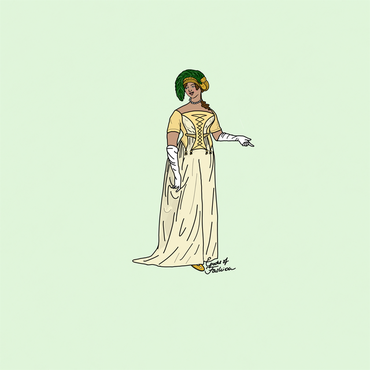
Jewellery:
During the Regency in England, comparatively a minimum of jewellery was worn. Necklaces (plain gold or with pendants, favourably cross-pendants or miniature portraits) and bracelets (around wrists, upper arms and ankles) as well as rings were chic. This fashion did certainly not stop rich ladies from showing their jewels, though. At evening parties and balls there was generally more jewellery worn.
In France it was different: the Emperor Napoleon had re-established a pompous court. Therefore, jewellery was used as a display of the social status. The coronation of Napoleon and his Josephine was a splendour and the appearances of the French imperial family with new styles were copied in many countries and influenced also England: For example, cameos became all the rage after Napoleons crown, decorated with them, had been seen. Pearls and all kinds of precious stones were worn. Empress Josephine often wore a set of various matching jewelleries, a Parure, that could consist of a tiara or diadem, a hair comb, earrings, a necklace, a bracelet, brooches and pins and rings.
During the Regency era, the gold price was comparatively high as a consequence of the American War of Independence, making gold jewellery even more luxurious. A very popular jewel was to have the hair of a beloved person set in a locked or ring. These hair jewels were real works of art with the hair beautifully braided or carefully arranged into often sentimental motifs of love, friendship, or piety.
Patterns:
- Laughing Moon Mercantile, e.g. LM 132 1800-1825 Petticoat, or LM 138 Dresses
- Sense and Sensibility Patterns
- Burda 2493 'Josephine'
- Butterick 6630 and 6631 (dresses)
- Simplicity 4052 (undergarments)
- Simplicity 4053 (undergarments)
- Simplicity 4055 (Empire/Regency dresses)
- Simplicity 9769 (actually it is Victorian but the shift might be also used for Regency clothing)
- Please note that this list claims no completeness and does not operate as advertisement. It was merely composed for informative purposes. Furthermore, no valuation of the patterns is implied or intended -
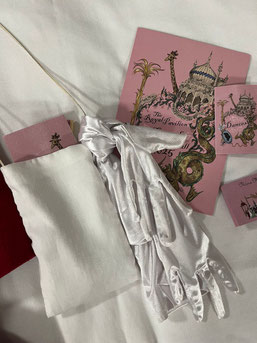
After Jane Austen Festival is before Jane Austen Festival! The beautiful city of Bath beckons again this coming September for the 250th anniversary of Jane Austen's birth!
I am already planning to sew a few new outfits for that. So far, I have always been incredibly lucky with sunny days during the festival but you never know as the British weather is notoriously unreliable...
I am aiming to make a Pelisse overcoat and at least one new hat!
© Epochs of Fashion



















